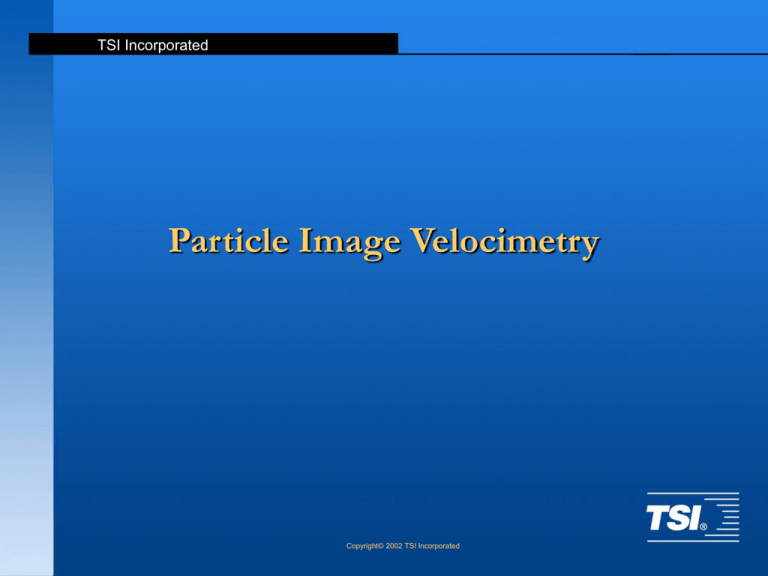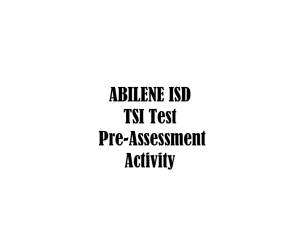1PIVIntro - enflo-sw
advertisement

TSI Incorporated
Particle Image Velocimetry
Copyright© 2002 TSI Incorporated
TSI Incorporated
Introduction to PIV
PIV is providing
– unique insight into the details of flow dynamics
– information about presence of flow structures
– spatial information about flow properties
Rapid changes in technology
– cameras, computers, ….
Copyright© 2002 TSI Incorporated
TSI Incorporated
Definition
Particle Image Velocimetry (PIV)
– an optical imaging technique to measure fluid or particulate
velocity vectors at many (e. g. thousands) points in a flow
field simultaneously.
– Measurements (2 or 3 components of velocity) usually made
in “Planar slices” of the flow field
Accuracy and spatial resolution
– comparable to LDV and HWA.
Copyright© 2002 TSI Incorporated
TSI Incorporated
PIV
LDV
Measurement at one point over a •
period of time.
Provides time history of the flow •
and hence time averaged statistics
at one point. Flow field mapped
by traversing the measuring
point.
•
Velocity obtained by measuring
time to travel a known distance.
Measurement at many points at
one instant of time.
Provides instantaneous vector
fields. Time averaged statistics
obtained by averaging several
image fields.
Velocity obtained by measuring
image displacement in a known
time.
Copyright© 2002 TSI Incorporated
TSI Incorporated
PIV - Principle
.
. .. .....
........
.
..
..
.
...
.. .
..
..
. .. .
. .. .
. ...
.. . .
..
.. ..
...
... .. . ..
..
..
....
. . ....
. .....
........ . .. .. .. ...
. .
..
..
.... . .
Laser light sheet
A
Dy
Dx
Flow plane
Dt - time between two pulses
Dx - particle displacement in x direction
Dy - particle displacement in y direction
Velocity of particle A
ux = Dx/Dt as Dt
uy = Dy/Dt as Dt
Copyright© 2002 TSI Incorporated
0
0
TSI Incorporated
PIV - Principle
Image plane
particle image
at time t1
particle image
at time t1 + Dt
A
DY
DX
DX = M*Dx
DY = M*Dy
Dt - time between two pulses
DX - particle image displacement in x direction
DY - particle image displacement in y direction
M - Magnification
ux = DX / (MDt)
uy = DY / (MDt)
Copyright© 2002 TSI Incorporated
TSI Incorporated
Cross correlation of frames
Each frame contains particle images from one laser
pulse.
–
Analysis by correlating the two image fields from separate
video frames.
Advantages:
–
–
–
works very well to >500 m/sec (with specially developed
cameras and frame straddling technique)
no additional hardware required to resolve flow direction
frames need not be successive (especially for measuring very
low speed flows)
Copyright© 2002 TSI Incorporated
TSI Incorporated
Crosscorrelation Processing
Interrogation
region
frame 1
Interrogation
region
Crosscorrelatio
n
particle
displacement
frame 2
Crosscorrelation
Vector field
Copyright© 2002 TSI Incorporated
TSI Incorporated
Frame straddling
Minimum frame straddling time
frame 1
frame 2
Camera Exposures
Pulse delay
Dt
Pulse separation
Laser Pulses
pulse 1
pulse 2
Copyright© 2002 TSI Incorporated
TSI Incorporated
Parameter setting
Magnification Determined by choice of Lens
Time between laser pulses set by user.
Laser power determines signal strength along with
aperture and seeding
How do we adjust laser power and aperture?
Copyright© 2002 TSI Incorporated
TSI Incorporated
What Do I need to consider before setting
up experiment?
Optical access
Seeding
Area I want to measure
Spatial Resolution
Errors in measurement
Copyright© 2002 TSI Incorporated
TSI Incorporated
Velocity measurement
Uncertainties in velocity estimate
u
umax
DX
DXmax
uDt
DXmax
Typically, Dns for pulsed lasers
u Dt
DX max
0.01 for...u 1000m / s
Copyright© 2002 TSI Incorporated
TSI Incorporated
Basics of set up
Seeding is good (aim for 5 particle pairs in each
interrogation spot)
Check particles a bigger than single pixel to avoid pixel
locking
Focus camera
Check timing between pulses
Copyright© 2002 TSI Incorporated
TSI Incorporated
POWERVIEWTM PIV system
2-component System
3-component System
Copyright© 2002 TSI Incorporated
TSI Incorporated
PIV System Components
Imaging Subsystem (Laser, Beam delivery system,
light optics)
– Illuminate a plane in the flow (seeded) using a pulsed laser
Image Capture Subsystem (CCD Camera, Camera
Interface, Synchronizer-Master control unit)
– Capture the particle images and record them
Analysis and Display Subsystem
– Calculates and displays a two dimensional vector field from
the particle image fields
Copyright© 2002 TSI Incorporated
TSI Incorporated
PIV System
LaserPulseTM mini-dual Nd:YAG Laser
LaserPulseTM Light Arm
Computer controlled LaserPulseTM Synchronizer
POWERVIEWTM Crosscorrelation cameras
POWERVIEWTM High speed CCD camera interface
INSIGHTTM
PIV software for Windows-2000, with
novel processing schemes
Copyright© 2002 TSI Incorporated
TSI Incorporated
Imaging Light Sources
Light
Source
Pulse
Duration
(m sec)
Pulse
Separation
(msec)
Energy/
Pulse
(mJ)
Repetition
Rate
(/sec)
YAG
0.004 to
0.020
selectable
15 to 400
15
Ar-ion
50
500
0.1 to 1.0
2000
Ruby
0.025
1.0
1000
0.01
Cu vapor
0.01
50
5
20 k
Copyright© 2002 TSI Incorporated
TSI Incorporated
Nd:YAG Laser
10 mJ - 400 mJ per pulse
4 ns - 20 ns pulse duration
– freezes the particle images
Wide range of DT
– to measure flow velocities from mm/s to supersonic speeds
10 - 30 Hz Pulse Repetition Rate
532 nm Wavelength (Frequency Doubled)
Copyright© 2002 TSI Incorporated
TSI Incorporated
Pulse energy - % of maximum
Energy vs. Q-switch delay
100%
80%
60%
40%
20%
0%
50
100
150
200
Q-Switch delay (microsec)
Copyright© 2002 TSI Incorporated
250
300
TSI Incorporated
LaserPulseTM mini-Dual YAG Laser
Solo Laser
New Wave Corp.
• Dual Nd:YAG laser
–
with integrated beam combination optics
• From 12 mJ/pulse up to 200 mJ/pulse
• Compact, light weight
(16 x 36 x 6 cm; 5 kg)
• 15 Hz pulse rate, effective 30 Hz
–
ideal for 30 frames/sec cameras
• Closed loop water cooling, 110 or 220V power
Copyright© 2002 TSI Incorporated
TSI Incorporated
Light Sheet Dimensions - YAG
Lasers
Spherical 100 mm
Cyl t
(mm) (m)
h
D
(mm) ()
200 mm
t
(m)
h D
(mm) ()
500 mm
t
(m)
h D
(mm) ()
1000 mm
t
(m)
h
D
(mm) ()
2000 mm
t
(m)
h D
(mm) ()
-12.7 10.6 41
19.9 21
88
23.3 53 230
25.2 106 466 25.9 212 939 26
10.6 18
6.9 21
42
10.3 53 114
12
21
18
3.4 53 54
5.5 106 114 6.2 212 234 6.5
-25
-50
106 234 13
212 474 13
-100
53 24
2.1 106 54
2.7 212 114 3.1
-200
53 9
0.34 106 24
1.0 212 54
t : Thickness of the light sheet at the waist in m
h : Height of the light sheet at the waist in mm
D: Divergence of the light sheet in degrees
Copyright© 2002 TSI Incorporated
1.4
TSI Incorporated
Light sheet Optics
• Compact Lens Assembly
• Combination of spherical and cylindrical lenses
– provides control over thickness and divergence of the light sheet
Spherical lens
wais
t
Cylindrical lens
Copyright© 2002 TSI Incorporated
TSI Incorporated
Synchronizer System
Camera
External trigger
Trigger
for seeder
Camera
interface
Laser
control
Computer
Copyright© 2002 TSI Incorporated
TSI Incorporated
Synchronization
External Trigger
Camera Trigger
Maximum Pulse
repetition rate
Camera Feedback
Image 1 Exposure
Camera Exposures
Camera
Image Readout
Image 2
Exposure
Image 1 Readout
Image 2 Readout
Pulse delay
Pulse separation
LaserPulses
Copyright© 2002 TSI Incorporated
TSI Incorporated
Architecture of CCD Transfer
Full frame transfer CCD
Frame transfer CCD
Interline transfer CCD
– Interlaced interline transfer
– Progressive scan interline transfer
Basic difference
– the process to move the image from the light sensitive pixels
to the horizontal shift register
Copyright© 2002 TSI Incorporated
TSI Incorporated
Important Specs to look out for
Dynamic Range
Resolution
Pixel Size
Frame Rate
Quantum Efficiency
Noise
Interframe time
Copyright© 2002 TSI Incorporated
TSI Incorporated
Sources of Noise in CCD chips
Noise is an unwanted signal, which is either contained
in the relevant light signal or added to it by imaging
process
Three common source of noise:
–
–
–
–
Photon or shot noise
CCD – image sensor noise mainly dark noise
Readout or amplifier noise
Total noise = {(Shot noise)2 + (CCD noise)2 + readout
noise)2}0.5
Copyright© 2002 TSI Incorporated
TSI Incorporated
Shot noise
Copyright© 2002 TSI Incorporated
TSI Incorporated
Effect of readout noise
Copyright© 2002 TSI Incorporated
TSI Incorporated
Dynamic range
Dynamic range of CCD
Digitization or Analog to Digital converter
specifications
Utilizable dynamic range
Copyright© 2002 TSI Incorporated
TSI Incorporated
Dynamic Range
Dynamic range of CCD: It is defined by most of the
sensor manufacturer as the ratio of full well capacity
to total noise
Bigger the size of the pixel, higher is the possible
dynamic range
Copyright© 2002 TSI Incorporated
TSI Incorporated
Dynamic range continued….
Dynamic range of digitization or Analog to Digital
converter
Copyright© 2002 TSI Incorporated
TSI Incorporated
Dynamic range continued….
Utilizable dynamic range is dependent on the CCD
dynamic range, A to D converter digitization factor and
readout circuit ( readout noise etc.)
Other important aspect of utilizable dynamic range is
application. For low light application it might be better
to have lower A to D conversion factor which can
provide better image quality at the expense of
theoretical dynamic range of camera
Copyright© 2002 TSI Incorporated
TSI Incorporated
PowerView 4MP
Key
–
–
–
–
–
features required for PIV:
Double shot capability
High resolution
Low noise
High sensitivity
High dynamic range
Copyright© 2002 TSI Incorporated
TSI Incorporated
POWERVIEW™ & PIVCAMTM
Crosscorrelation cameras
Family of
–
On-board buffer memory for fast discharge between
frames
–
allows “frame straddling”
Minimum time between two frames
–
Digital, High resolution, progressive scan CCD cameras
optimized for PIV
200 nsec
High resolution - up to 4008 x 2672
High frame rate - up to 30 frames/sec
Copyright© 2002 TSI Incorporated
TSI Incorporated
TSI PIV Cameras
Camera
Pixels
Rate
PowerView 11MP
4008 x 2672
4.8Hz
POWERVIEW 4M
2048 x 2048
17 Hz
POWERVIEW 2M
1660 x 1200
30 Hz
PIVCAM 13-8
1280 x1024
8 Hz
PIVCAM 10-30
1008 x 1018
30 Hz
35 mm Film
3800 x 2500
5 Hz
Copyright© 2002 TSI Incorporated
TSI Incorporated
PIVCAM Cameras
PIVCAM 10-30
•
•
•
1K x 1K resolution
30 frames per second
Frame-straddling camera
PIVCAM 13-8
•
•
•
1.3 K x 1K resolution (12 bit)
8 frames per second
Frame-straddling camera
Copyright© 2002 TSI Incorporated
TSI Incorporated
POWERVIEWTM Cameras
200 nsec minimum
frame-straddling
time – can be used
for hypersonic flow
measurements
Lowest noise of any
PIV digital camera
for exceptional
contrast.
POWERVIEW 2M
1660 x 1200 pixels
Integrated
protective mask
to eliminate laser
damage.
POWERVIEW 4M
2048 x 2048 pixels
Standard F-mount
for easy lens interchangeability
12-bit digital
output
Copyright© 2002 TSI Incorporated
High pixel
resolution
progressive scan
CCD.
TSI Incorporated
POWERVIEWTM Cameras
Compact design
– Far easier to use with microscopes and
micro-PIV optics for micro-PIV
applications
– For packged PIV systems
POWERVIEW 2M
• e.g., underwater applications
More pixels per particle image
– Higher measurement accuracy
– High spatial resolution
– Ability to image large flow fields
Multibit cameras
– Suited for PLIF
Remote Focusing feature
Copyright© 2002 TSI Incorporated
POWERVIEW 4M
TSI Incorporated
POWERVIEWTM 4M Cameras
Enhanced Resolution
PowerView 4M Camera
2048 x 2048 pixels
1280 x 1024 pixels
Copyright© 2002 TSI Incorporated
TSI Incorporated
External Trigger
Allows PIV measurements at specific instants
–
based on a trigger signal input to Synchronizer
Experiment triggers the Synchronizer (timing master)
–
Synchronizer activates lasers, camera and starts image capture
Requires a triggered camera for precise timing
Synchronizer can be programmed to trigger the laser at
a specified delay time after an event
Copyright© 2002 TSI Incorporated
TSI Incorporated
POWERVIEWTM Camera Interface
Fast transfer of CCD camera image direct to PC RAM
–
–
–
Follows flow fluctuations
–
limited by laser pulse rate and camera frame rate
Required transfer rate for PowerView 2M camera
–
90MB/sec peak transfer rate
60MB/sec sustained transfer rate
PC RAM now inexpensive, large capacity available
1660 x 1200 at 15Hz = 60MB/s
Two camera interfaces are used in Stereo PIV
Copyright© 2002 TSI Incorporated




